VENTAVIS- iloprost solution
VENTAVIS by
Drug Labeling and Warnings
VENTAVIS by is a Prescription medication manufactured, distributed, or labeled by Actelion Pharmaceuticals US, Inc., BERLIMED SA, Bayer AG, Currenta GmbH & Co. OHG. Drug facts, warnings, and ingredients follow.
Drug Details [pdf]
-
HIGHLIGHTS OF PRESCRIBING INFORMATION
These highlights do not include all the information needed to use VENTAVIS safely and effectively. See full prescribing information for VENTAVIS.
VENTAVIS® (iloprost) inhalation solution, for oral inhalation use
Initial U.S. Approval: 2004INDICATIONS AND USAGE
Ventavis® is a prostacyclin mimetic indicated for the treatment of pulmonary arterial hypertension (PAH) (WHO Group 1) to improve a composite endpoint consisting of exercise tolerance, symptoms (NYHA Class), and lack of deterioration. Studies establishing effectiveness included predominately patients with NYHA Functional Class III-IV symptoms and etiologies of idiopathic or heritable PAH (65%) or PAH associated with connective tissue diseases (23%). (1.1).
DOSAGE AND ADMINISTRATION
Ventavis is intended to be inhaled using the I-neb® AAD® System. Patients should receive 6 to 9 doses (inhalations) per day (minimum of 2 hours between doses during waking hours) as follows:
- Starting dose: 2.5 mcg (2.1).
- Uptitrate to 5 mcg if 2.5 mcg is well tolerated (2.1).
- Maintenance dose: 5 mcg (2.1).
Delivered dose from ampule of: Nebulizer 10 mcg/mL 20 mcg/mL I-neb® AAD® 2.5 or 5 mcg from one ampule 5 mcg from one ampule - The 20 mcg/mL concentration is for patients who repeatedly experience extended treatment times (2.1).
DOSAGE FORMS AND STRENGTHS
1 mL ampules in two concentrations: 10 mcg/mL and 20 mcg/mL (3).
CONTRAINDICATIONS
None (4)
WARNINGS AND PRECAUTIONS
- Hypotension leading to syncope has been observed. Monitor vital signs while initiating Ventavis. Ventavis should not be administered in patients with systolic blood pressure below 85 mmHg (5.1).
- Pulmonary venous hypertension: Discontinue if pulmonary edema is present (5.2).
- May cause bronchospasm: Patients with a history of hyperreactive airway disease may be more sensitive (5.3).
- Avoid contact with skin and eyes and ingestion (5.4).
ADVERSE REACTIONS
Most common (≥3% placebo adjusted) adverse reactions are vasodilation (flushing), cough increased, headache, trismus, insomnia, nausea, hypotension, vomiting, alkaline phosphatase increased, flu syndrome, back pain, tongue pain, palpitations, syncope, GGT increased, muscle cramps, hemoptysis, and pneumonia (6.1).
To report SUSPECTED ADVERSE REACTIONS, contact Actelion at 1-866-228-3546 or FDA at 1-800-FDA-1088 or www.fda.gov/medwatch.DRUG INTERACTIONS
USE IN SPECIFIC POPULATIONS
See 17 for PATIENT COUNSELING INFORMATION and FDA-approved patient labeling.
Revised: 12/2019
-
Table of Contents
FULL PRESCRIBING INFORMATION: CONTENTS*
1. INDICATIONS AND USAGE
1.1 Pulmonary Arterial Hypertension
2. DOSAGE AND ADMINISTRATION
2.1 Recommended Dosing
2.2 Use in Patients with Pre-existing Hepatic Impairment
2.3 Use in Patients with Pre-existing Renal Impairment
3. DOSAGE FORMS AND STRENGTHS
4. CONTRAINDICATIONS
5. WARNINGS AND PRECAUTIONS
5.1 Risk of Syncope
5.2 Pulmonary Venous Hypertension
5.3 Bronchospasm
5.4 Avoid Contact with Skin and Eyes and Ingestion
6. ADVERSE REACTIONS
6.1 Clinical Studies Experience
6.2 Postmarketing Experience
7. DRUG INTERACTIONS
7.1 Antihypertensives and Vasodilators
7.2 Anticoagulants and Platelet Inhibitors
8. USE IN SPECIFIC POPULATIONS
8.1 Pregnancy
8.2 Lactation
8.4 Pediatric Use
8.5 Geriatric Use
8.6 Hepatic Impairment
8.7 Renal Impairment
10. OVERDOSAGE
11. DESCRIPTION
12. CLINICAL PHARMACOLOGY
12.1 Mechanism of Action
12.3 Pharmacokinetics
13. NONCLINICAL TOXICOLOGY
13.1 Carcinogenesis, Mutagenesis, Impairment of Fertility
14. CLINICAL STUDIES
16. HOW SUPPLIED/STORAGE AND HANDLING
17. PATIENT COUNSELING INFORMATION
- * Sections or subsections omitted from the full prescribing information are not listed.
-
1. INDICATIONS AND USAGE
1.1 Pulmonary Arterial Hypertension
Ventavis® is indicated for the treatment of pulmonary arterial hypertension (PAH) (WHO Group 1) to improve a composite endpoint consisting of exercise tolerance, symptoms (NYHA Class), and lack of deterioration. Studies establishing effectiveness included predominately patients with NYHA Functional Class III–IV symptoms and etiologies of idiopathic or heritable PAH (65%) or PAH associated with connective tissue diseases (23%) [see Clinical Studies (14)].
-
2. DOSAGE AND ADMINISTRATION
2.1 Recommended Dosing
Ventavis is intended to be inhaled using the I-neb® AAD® System. The recommended initial inhaled dose is 2.5 mcg (as delivered at the mouthpiece). If well tolerated, increase dosing to 5.0 mcg and maintain at that dose; otherwise maintain the dose at 2.5 mcg [see Warnings and Precautions (5.1)]. Ventavis should be taken 6 to 9 times per day (no more than once every 2 hours) during waking hours, according to individual need and tolerability. The maximum daily dose evaluated in clinical studies was 45 mcg (5 mcg 9 times per day).
Direct mixing of Ventavis with other medications in the I-neb® AAD® System has not been evaluated; do not mix with other medications. To avoid potential interruptions in drug delivery due to equipment malfunctions, the patient should have easy access to a back-up I-neb®AAD® System.
Ventavis is supplied in 1 mL ampules in two concentrations: 10 mcg/mL and 20 mcg/mL.
Delivered dose from ampule of : Nebulizer 10 mcg/mL 20 mcg/mL I-neb® AAD® 2.5 or 5 mcg from one ampule 5 mcg from one ampule The 20 mcg/mL concentration is intended for patients who are maintained at the 5 mcg dose and who have repeatedly experienced extended treatment times which could result in incomplete dosing. Transitioning patients to the 20 mcg/mL concentration using the I-neb® AAD® System will decrease treatment times to help maintain patient compliance.
For each inhalation session, the entire contents of each opened ampule of Ventavis should be transferred into the I-neb® AAD® System medication chamber immediately before use. Discard any solution remaining in the medication chamber after each inhalation session. Patients should follow the manufacturer's instructions for cleaning the I-neb® AAD® System components after each dose administration.
2.2 Use in Patients with Pre-existing Hepatic Impairment
Because iloprost elimination is reduced in patients with impaired liver function [see Use in Specific Populations (8.6)], consider increasing the dosing interval (e.g., 3–4 hours between doses depending on the patient's response at the end of the dose interval) in patients with Child-Pugh Class B or C hepatic impairment.
2.3 Use in Patients with Pre-existing Renal Impairment
Dose adjustment is not required in patients who are not on dialysis. The effect of dialysis on iloprost is unknown [see Use in Specific Populations (8.7)].
- 3. DOSAGE FORMS AND STRENGTHS
- 4. CONTRAINDICATIONS
-
5. WARNINGS AND PRECAUTIONS
5.1 Risk of Syncope
Monitor vital signs while initiating Ventavis. Do not initiate Ventavis in patients with systolic blood pressure below 85 mmHg. Syncope can also occur in association with pulmonary arterial hypertension, particularly in association with physical exertion. The occurrence of exertional syncope may reflect a therapeutic gap or insufficient efficacy, and the need to adjust dose or change therapy should be considered.
5.2 Pulmonary Venous Hypertension
Should signs of pulmonary edema occur when inhaled Ventavis is administered in patients with pulmonary hypertension, stop treatment immediately, as this may be a sign of pulmonary venous hypertension.
5.3 Bronchospasm
Ventavis inhalation can induce bronchospasm. Bronchospasm may be more severe or frequent in patients with a history of hyperreactive airways. Ventavis has not been evaluated in patients with chronic obstructive pulmonary disease (COPD), severe asthma, or with acute pulmonary infections.
-
6. ADVERSE REACTIONS
6.1 Clinical Studies Experience
Because clinical trials are conducted under widely varying conditions, adverse reaction rates observed in the clinical trials of a drug cannot be directly compared to rates in the clinical trials of another drug and may not reflect the rates observed in practice.
Pre-marketing safety data on Ventavis were obtained from 215 patients with PAH receiving iloprost in two 12-week clinical trials and two long-term extensions. Patients received inhaled Ventavis for periods of from 1 day to more than 3 years. The median number of weeks of exposure was 15. Forty patients completed 12 months of open-label treatment with iloprost.
The following table shows adverse events reported by at least 4 Ventavis patients and reported at least 3% more frequently for Ventavis patients than placebo patients in the 12-week placebo-controlled study.
Table 1: Adverse Events in Phase 3 Clinical Trial Adverse Event Ventavis
n = 101Placebo
n = 102Placebo subtracted % Vasodilation (flushing) 27 9 18 Cough increased 39 26 13 Headache 30 20 10 Trismus 12 3 9 Insomnia 8 2 6 Nausea 13 8 5 Hypotension 11 6 5 Vomiting 7 2 5 Alk phos increased 6 1 5 Flu syndrome 14 10 4 Back pain 7 3 4 Tongue pain 4 0 4 Palpitations 7 4 3 Syncope 8 5 3 GGT increased 6 3 3 Muscle cramps 6 3 3 Hemoptysis 5 2 3 Pneumonia 4 1 3 Pre-marketing serious adverse events reported with the use of inhaled Ventavis and not shown in Table 1 include congestive heart failure, chest pain, supraventricular tachycardia, dyspnea, peripheral edema, and kidney failure.
In a small clinical trial (the STEP trial) [see Clinical Studies (14)], safety trends in patients receiving concomitant bosentan and Ventavis were consistent with those observed in the larger experience of the Phase 3 study in patients receiving only Ventavis or bosentan.
Adverse events with higher doses
In a study in healthy subjects (n = 160), inhaled doses of iloprost solution were given every 2 hours, beginning with 5 mcg and increasing up to 20 mcg for a total of 6 dose inhalations (total cumulative dose of 70 mcg) or up to the highest dose tolerated in a subgroup of 40 subjects. There were 13 subjects (32%) who failed to reach the highest scheduled dose (20 mcg). Five were unable to increase the dose because of (mild to moderate) transient chest pain/discomfort/tightness, usually accompanied by headache, nausea, and dizziness. The remaining 8 subjects discontinued for other reasons.
6.2 Postmarketing Experience
The following adverse reactions have been identified during the post-approval use of Ventavis. Because these reactions are reported voluntarily from a population of uncertain size, it is not always possible to reliably estimate their frequency or establish a causal relationship to drug exposure.
Cases of bronchospasm and wheezing have been reported, particularly in patients with a history of hyperreactive airways [see Warnings and Precautions (5.3)]. Bleeding events most commonly reported as epistaxis and hemoptysis were observed on Ventavis treatment [see Drug Interactions (7.2)]. Cases of thrombocytopenia, dizziness, diarrhea, mouth and tongue irritation, nasal congestion, dysgeusia, hypersensitivity, and rash have also been reported with the use of Ventavis.
-
7. DRUG INTERACTIONS
7.1 Antihypertensives and Vasodilators
In studies in normal subjects, there was no pharmacodynamic interaction between intravenous iloprost and either nifedipine, diltiazem, or captopril. However, Ventavis has the potential to increase the hypotensive effect of vasodilators and antihypertensive agents.
-
8. USE IN SPECIFIC POPULATIONS
8.1 Pregnancy
Risk Summary
Limited published data from case series and case reports with Ventavis in pregnant women have not identified a drug-associated risk of major birth defects, miscarriage or adverse maternal or fetal outcomes. There are risks to the mother and fetus associated with pulmonary arterial hypertension (see Clinical Considerations). In animal reproductive studies, administration of continuous intravenous iloprost to pregnant Han-Wistar rats during organogenesis at doses 2-times the recommended human dose on a mg/m2 basis resulted in adverse developmental outcomes. However, there were no adverse developmental outcomes with intravenous administration of iloprost to pregnant Sprague-Dawley rats, rabbits and monkeys at doses 1200-, 180-, and 14-times, respectively, the recommended human dose on a mg/m2 basis (see Data).
The estimated background risk of major birth defects and miscarriage for the indicated populations is unknown. All pregnancies have a background risk of birth defect, loss, or other adverse outcomes. In the U.S. general population, the estimated background risk of major birth defects and miscarriage in clinically recognized pregnancies is 2 to 4% and 15 to 20%, respectively.
Data
Animal Data
In developmental toxicity studies in pregnant Han-Wistar rats, continuous intravenous administration of iloprost at a dosage of 0.01 mg/kg daily (serum levels not available) led to shortened digits of the thoracic extremity in fetuses and pups. In comparable studies in pregnant Sprague-Dawley rats which received iloprost clathrate (13% iloprost by weight) orally at dosages of up to 50 mg/kg/day (Cmax of 90 ng/mL), in pregnant rabbits at intravenous dosages of up to 0.5 mg/kg/day (Cmax of 86 ng/mL), and in pregnant monkeys at dosages of up to 0.04 mg/kg/day (serum levels of 1 ng/mL), no such digital anomalies or other gross-structural abnormalities were observed in the fetuses/pups. However, in gravid Sprague-Dawley rats, iloprost clathrate (13% iloprost) significantly increased the number of non-viable fetuses at a maternally toxic oral dosage of 250 mg/kg/day and in Han-Wistar rats was found to be embryolethal in 15 of 44 litters at an intravenous dosage of 1 mg/kg/day.
8.2 Lactation
Risk Summary
There are no data on the presence of iloprost in human milk, the effects on the breastfed infant, or the effects on milk production. Iloprost is present in rat milk (see Data). When a drug is present in animal milk, it is likely that the drug will be present in human milk.
Because of the potential for serious adverse reactions, advise women not to breastfeed during treatment with Ventavis [see Warnings and Precautions (5) and Adverse Reactions (6)].
Data
Animal Data
In studies with Han-Wistar rats, higher mortality was observed in pups of lactating dams receiving iloprost intravenously at 1 mg/kg daily. In Sprague-Dawley rats, higher mortality was also observed in nursing pups at a maternally toxic oral dose of 250 mg/kg/day of iloprost clathrate (13% iloprost by weight). In rats a passage of low levels of iloprost or metabolites in to the milk was observed (less than 1% of iloprost dose given intravenously). No disturbance of post-natal development and reproductive performance was seen in animals exposed during lactation.
8.5 Geriatric Use
Clinical studies of Ventavis did not include sufficient numbers of subjects aged 65 and older to determine whether they respond differently than younger subjects. Other reported clinical experience has not identified differences in responses between elderly and younger patients. In general, dose selection for an elderly patient should be cautious, usually starting at the low end of the dosing range, reflecting the greater frequency of decreased hepatic, renal, or cardiac function, and of concomitant disease or other drug therapy.
8.6 Hepatic Impairment
Ventavis has not been evaluated in subjects with impaired hepatic function. However, in an intravenous iloprost study in patients with liver cirrhosis, the mean clearance in Child- Pugh Class B subjects (n = 5) was approximately 10 mL/min/kg (half that of healthy subjects). Following oral administration, the mean AUC0-8h in Child-Pugh Class B subjects (n = 3) was 1725 pg*h/mL compared to 117 pg*h/mL in normal subjects (n = 4) receiving the same oral iloprost dose. In Child-Pugh Class A subjects (n = 5), the mean AUC0-8h was 639 pg*h/mL. Although exposure increased with hepatic impairment, there was no effect on half-life.
8.7 Renal Impairment
Ventavis has not been evaluated in subjects with impaired renal function. However, in a study with intravenous infusion of iloprost in patients with end-stage renal failure requiring intermittent dialysis treatment (n=7), the mean AUC0-4h was 230 pg*h/mL compared to 54 pg*h/mL in patients with renal failure (n=8) not requiring intermittent dialysis and 48 pg*h/mL in normals. The half-life was similar in both groups. The effect of dialysis on iloprost exposure has not been evaluated.
-
10. OVERDOSAGE
Cases of overdose have been reported. Frequently observed symptoms following overdose are dizziness, headache, flushing, nausea, jaw pain or back pain. Hypotension, vomiting, and diarrhea are possible. A specific antidote is not known. Interruption of the inhalation session, monitoring, and symptomatic measures are recommended.
-
11. DESCRIPTION
Ventavis (iloprost) Inhalation Solution is a clear, colorless, sterile solution containing iloprost formulated for inhalation via the I-neb® AAD® (Adaptive Aerosol Delivery) System. Ventavis is supplied in 1 mL single-use glass ampules containing either 10 mcg/mL or 20 mcg/mL.
For the 10 mcg/mL solution, one mL of the solution contains 0.01 mg iloprost, 0.81 mg ethanol, 0.121 mg tromethamine, 9.0 mg sodium chloride, and approximately 0.51 mg hydrochloric acid (for pH adjustment to 8.1) in water for injection.
For the 20 mcg/mL solution, one mL of the solution contains 0.02 mg iloprost, 1.62 mg ethanol, 0.242 mg tromethamine, 9.0 mg sodium chloride, and approximately 0.76 mg hydrochloric acid (for pH adjustment to 8.4) in water for injection.
The solution contains no preservatives.
The chemical name for iloprost is (E)-(3aS, 4R, 5R, 6aS)-hexahydro-5-hydroxy-4-[(E)-(3S,4RS)-3-hydroxy-4-methyl-1-octen-6-ynyl]-Δ2(1H),Δ-pentalenevaleric acid. Iloprost consists of a mixture of the 4R and 4S diastereoisomers at a ratio of approximately 53:47. Iloprost is an oily substance, which is soluble in methanol, ethanol, ethyl acetate, acetone, and pH 7 buffer, sparingly soluble in buffer pH 9, and very slightly soluble in distilled water, buffer pH 3, and buffer pH 5. The molecular formula of iloprost is C22H32O4. Its relative molecular weight is 360.49. The structural formula is shown below:
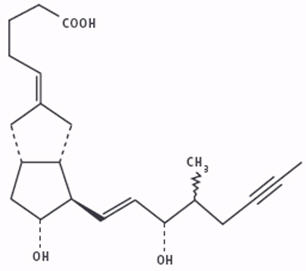
-
12. CLINICAL PHARMACOLOGY
12.1 Mechanism of Action
Iloprost is a synthetic analog of prostacyclin PGI2. Iloprost dilates systemic and pulmonary arterial vascular beds. It also affects platelet aggregation but the relevance of this effect to the treatment of pulmonary hypertension is unknown. The two diastereoisomers of iloprost differ in their potency in dilating blood vessels, with the 4S isomer substantially more potent than the 4R isomer.
12.3 Pharmacokinetics
General: In pharmacokinetic studies in animals, there was no evidence of interconversion of the two diastereoisomers of iloprost. In human pharmacokinetic studies, the two diastereoisomers were not individually assayed.
Iloprost administered intravenously has linear pharmacokinetics over the dose range of 1 to 3 ng/kg/min. The half-life of iloprost is 20 to 30 minutes. Following inhalation of iloprost (5 mcg) patients with pulmonary hypertension have iloprost peak plasma levels of approximately 150 pg/mL. Iloprost was generally not detectable in plasma 30 minutes to 1 hour after inhalation.
Absorption and Distribution: The absolute bioavailability of inhaled iloprost has not been determined. Following intravenous infusion, the apparent steady-state volume of distribution was 0.7 to 0.8 L/kg in healthy subjects. Iloprost is approximately 60% protein-bound, mainly to albumin, and this ratio is concentration-independent in the range of 30 to 3000 pg/mL.
Metabolism and Excretion: In vitro studies reveal that cytochrome P450-dependent metabolism plays only a minor role in the biotransformation of iloprost. Iloprost is metabolized principally via β-oxidation of the carboxyl side chain. The main metabolite is tetranor-iloprost, which is found in the urine in free and conjugated form. In animal experiments, tetranor-iloprost was pharmacologically inactive.
Clearance in normal subjects was approximately 20 mL/min/kg.
A mass-balance study using intravenously and orally administered [3H]-iloprost in healthy subjects (n = 8) showed recovery of 81% of total radioactivity over 14 hours post-dose, with 68% and 12% recoveries in urine and feces, respectively.
Drug Interactions
During clinical trials, iloprost was used concurrently with anticoagulants, diuretics, cardiac glycosides, calcium channel blockers, analgesics, antipyretics, nonsteroidal anti-inflammatory drugs, corticosteroids, and other medications. Intravenous infusion of iloprost had no effect on the pharmacokinetics of digoxin. Acetylsalicylic acid did not alter the clearance (pharmacokinetics) of iloprost.
-
13. NONCLINICAL TOXICOLOGY
13.1 Carcinogenesis, Mutagenesis, Impairment of Fertility
Iloprost was not mutagenic in bacterial and mammalian cells in the presence or absence of extrinsic metabolic activation. Iloprost did not cause chromosomal aberrations in vitro in human lymphocytes and was not clastogenic in vivo in NMRI/SPF mice. There was no evidence of a tumorigenic effect of iloprost clathrate (13% iloprost by weight) in Sprague-Dawley rats dosed orally for up to 8 months at doses of up to 125 mg/kg/day (Cmax of 45 ng/mL serum), followed by 16 months at 100 mg/kg/day, or in Crl:CD-1®(ICR)BR albino mice dosed orally for up to 24 months at doses of up to 125 mg/kg/day (Cmax of 156 ng/mL serum). The recommended clinical dosage regimen for iloprost (5 mcg) affords a serum Cmax of 0.16 ng/mL. Fertility of males or females was not impaired in Han-Wistar rats at intravenous doses up to 1 mg/kg/day.
-
14. CLINICAL STUDIES
A randomized, double-blind, multi-center, placebo-controlled trial was conducted in 203 adult patients (inhaled iloprost: n = 101; placebo: n = 102) with NYHA Class III or IV PAH (WHO Group 1); idiopathic in 53%, associated with connective tissue disease, including CREST and scleroderma, in 17%, or associated with anorexigen use in 2%) or PAH related to chronic thromboembolic disease (WHO Group 4; 28%). Inhaled iloprost (or placebo) was added to patients' current therapy, which could have included anticoagulants, vasodilators (e.g., calcium channel blockers), diuretics, oxygen, and digoxin, but not PGI2 (prostacyclin or its analogs) or endothelin receptor antagonists. Patients received 2.5 or 5.0 mcg of iloprost by repeated inhalations 6 to 9 times per day during waking hours. The mean age of the entire study population was 52 years and 68% of the patients were female. The majority of patients (59%) were NYHA Class III. The baseline 6-minute walk test values reflected a moderate exercise limitation (the mean was 332 meters for the iloprost group and 315 meters for the placebo group). In the iloprost group, the median daily inhaled dose was 30 mcg (range of 12.5 to 45 mcg/day). The mean number of inhalations per day was 7.3. Ninety percent of patients in the iloprost group never inhaled study medication during the nighttime.
The primary efficacy endpoint was clinical response at 12 weeks, a composite endpoint defined by: a) improvement in exercise ability (6-minute walk test) by at least 10% versus baseline evaluated 30 minutes after dosing, b) improvement by at least one NYHA class versus baseline, and c) no death or deterioration of pulmonary hypertension. Deterioration required two or more of the following criteria: 1) refractory systolic blood pressure < 85 mmHg, 2) worsening of right heart failure with cardiac edema, ascites, or pleural effusion despite adequate background therapy, 3) rapidly progressive cardiogenic hepatic failure (e.g., leading to an increase of GOT or GPT to > 100 U/L, or total bilirubin ≥ 5 mg/dL), 4) rapidly progressive cardiogenic renal failure (e.g., decrease of estimated creatinine clearance to ≤ 50% of baseline), 5) decrease in 6-minute walking distance by ≥ 30% of baseline value, 6) new long-term need for i.v. catecholamines or diuretics, 7) cardiac index ≤ 1.3 L/min/m2, 8) CVP ≥ 22 mmHg despite adequate diuretic therapy, and 9) SVO2 ≤ 45% despite nasal O2 therapy.
Although effectiveness was seen in the full population (response rates for the primary composite endpoint of 17% and 5%; p = 0.007), there was inadequate evidence of benefit in patients with pulmonary hypertension associated with chronic thromboembolic disease (WHO Group 4); the results presented are therefore those related to patients with PAH (WHO Group 1). The response rate for the primary efficacy endpoint among PAH patients was 19% for the iloprost group, compared with 4% for the placebo group (p = 0.0033). All three components of the composite endpoint favored iloprost (Figure 1).
Figure 1: Composite Primary Endpoint for PAH Patients (WHO Group I)
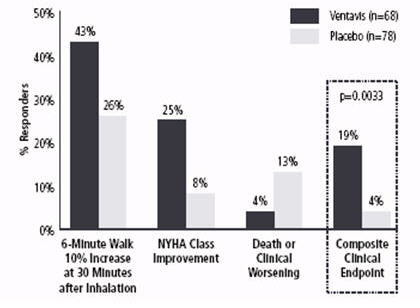
The absolute change in 6-minute walk distance (Figure 2) measured (using all available data and no imputation) 30 minutes after inhalation among patients with PAH was greater in the iloprost group compared to the placebo group at all time points. At Week 12, the placebo-corrected difference was 40 meters (p < 0.01). When walk distance was measured immediately prior to inhalation, the improvement compared to placebo was approximately 60% of the effect seen at 30 minutes after inhalation.
Figure 2: Change (Mean ± SEM) in 6-Minute Walk Distance 30 Minutes Post-inhalation in PAH Patients (WHO Group 1).
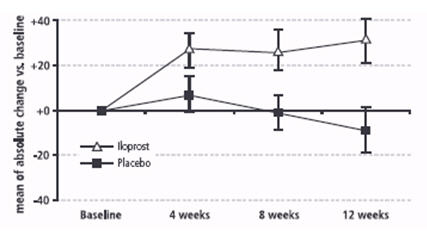
The effect of Ventavis in various subgroups is shown in Table 2.
Table 2: Treatment Effects by Subgroup among PAH Patients (WHO Group 1) Composite Clinical Endpoint 6-Minute Walk (m)* n Ventavis
n (%)n Placebo
n (%)n Ventavis
(mean ±SD)n Placebo
(mean ±SD)- * Change from baseline to 12 Weeks with measurement 30 minutes after dosing, based on all available data.
- † Etiologies of PAH, WHO Group 1 included idiopathic in 62% (n = 90), associated with connective tissue disease, including CREST and scleroderma, in 17%, (n = 25), associated with anorexigen use in 6% (n = 9), heritable PAH in 3% (n = 5), other PPH in 3% (n = 5), SLE in 1% (n = 2), post-partum in 1% (n = 2), and overlap/other in 5% (n = 8).
All Subjects with PAH†
68 13 (19%) 78 3 (4%) 64 31 ± 76 65 -9 ± 79 NYHA III 40 7 (18%) 47 2 (4%) 39 24 ± 72 43 -16 ± 86 NYHA IV
28 6 (21%) 31 1 (3%) 25 43 ± 82 22 6 ± 63 Male 23 5 (22%) 24 0 (0%) 21 37 ± 81 21 -22 ± 77 Female
45 8 (18%) 54 3 (6%) 43 29 ± 74 44 -2 ± 81 Age ≤ 55 41 6 (15%) 40 2 (5%) 39 24 ± 79 32 -5 ± 78 Age > 55 27 7 (26%) 38 1 (3%) 25 42 ± 71 33 -13 ± 81 Hemodynamic assessments obtained at Week 12 before inhalation in both groups (at least 2 hours after a previous dose, trough) and after inhalation in the iloprost group (approximately 15 minutes after a dose, peak), are shown in Table 3. The relationship between hemodynamic changes and clinical effects is unknown.
Table 3 Hemodynamic Parameters Before and After Iloprost Inhalation: Change from Baseline to Week 12* Baseline Mean (± SD) change from baseline at Week 12 Parameter Iloprost Placebo Iloprost Placebo Before Inhalation After Inhalation - * Patients of all etiologies of PAH, including CTEPH.
PVR (dyn∙s∙cm–5) 1029 ± 390 1041 ± 493 -9 ± 275
(n = 76)-239 ± 279
(n = 70)+96 ± 323
(n = 77)mPAP (mmHg) 53 ± 12 54 ± 14 -0.2 ± 7.3
(n = 93)-4.6 ± 9.3
(n = 90)-0.1 ± 6.9
(n = 82)CO (L/min) 3.8 ± 1.1 3.8 ± 0.9 +0.1 ± 0.9
(n = 91)+0.5 ± 1.1
(n = 89)-0.2 ± 0.8
(n = 80)SVO2 (%)
60 ± 8 60± 8 -1.1 ± 7.6
(n = 72)+1.8 ± 8.3
(n = 70)-3.2 ± 6.7
(n = 63)In a small, randomized, double-blind, placebo-controlled study (the STEP trial), 34 patients treated with bosentan 125 mg bid for at least 16 weeks tolerated the addition of inhaled iloprost (up to 5 mcg 6 to 9 times per day during waking hours). The mean daily inhaled dose was 27 mcg and the mean number of inhalations per day was 5.6.
-
16. HOW SUPPLIED/STORAGE AND HANDLING
Ventavis (iloprost) Inhalation Solution is supplied in cartons of 30 × 1 mL clear glass single-use ampules as follows:
1 mL ampule containing iloprost 10 mcg per mL, carton of 30 (NDC: 66215-302-30)
1 mL ampule containing iloprost 20 mcg per mL, carton of 30 (NDC: 66215-303-30)
-
17. PATIENT COUNSELING INFORMATION
Advise patients to read the FDA-approved patient labeling (Patient Information).
Advise patients that they may have a fall in blood pressure with Ventavis, so they may become dizzy or even faint. They should stand up slowly when they get out of a chair or bed. If fainting gets worse, patients should consult their physicians about dose adjustment.
Advise patients that Ventavis should be inhaled at intervals of not less than 2 hours and that the acute benefits of Ventavis may not last 2 hours. Thus, patients may want to adjust times of administration to cover planned activities.
- SPL UNCLASSIFIED SECTION
-
PATIENT PACKAGE INSERT
PATIENT INFORMATION
Ventavis® (ven TAY vis)
(iloprost)
Inhalation SolutionRead the Patient Information that comes with Ventavis before you start using it and each time you get a refill. There may be new information. The leaflet does not take the place of talking with your doctor about your medical condition or your treatment.
What is Ventavis?
Ventavis is a prescription medicine used to treat adults with certain kinds of severe pulmonary arterial hypertension (PAH), a condition in which blood pressure is too high in the blood vessels between the heart and the lungs. Ventavis may improve your ability to exercise and your symptoms for a short time by lowering your blood pressure and opening up the blood vessels in your lungs.
Ventavis has not been studied in children younger than 18 years old.
What should I tell my doctor before taking Ventavis?
Ventavis may not be right for you. Before taking Ventavis, tell your doctor about all of your medical conditions, including if you:
- have liver or kidney problems. Your doctor may need to give you a lower dose of Ventavis.
- are pregnant, or plan to become pregnant. It is not known if Ventavis can harm your unborn baby. Ventavis should only be used during pregnancy if the benefit to you is worth the possible risk to your baby.
- are breast-feeding. It is not known if Ventavis passes into your breast milk. You and your doctor should decide if you will take Ventavis or breast feed.
Tell your doctor about all the medicines you take, including prescription and nonprescription medicines, vitamins, and herbal supplements.
Ventavis and other medicines may affect each other causing side effects. Ventavis may affect the way other medicines work, and other medicines may affect how Ventavis works.
Especially tell your doctor if you take:
- medicines used to treat high blood pressure or heart problems
- medicines that lessen blood clotting (warfarin, Coumadin, Jantoven)
Know the medicines you take. Keep a list of your medicines and show it to your doctor and pharmacist when you get a new medicine.
How should I take Ventavis?
See the end of this leaflet for detailed instructions for using Ventavis.
- Take Ventavis exactly as your doctor tells you to take it. Your doctor may change your dose if needed.
- You should not take Ventavis more than every 2 hours. The benefits of Ventavis may not last 2 hours, so you may adjust the times that you use it to cover planned activities.
- Do not drink Ventavis.
- Do not let Ventavis solution come into contact with your skin or eyes. If it does, rinse your skin or eyes with water right away.
- Do not allow other people to be exposed to Ventavis while you are breathing it, especially babies.
- If you take too much Ventavis, you may have a headache, red face, dizziness, nausea, vomiting and diarrhea. If this happens stop taking Ventavis. If your symptoms do not go away, call your doctor or get emergency help right away.
What are the possible side effects of Ventavis?
Ventavis may cause side effects, including feeling dizzy, lightheaded and faint. If you have any of these side effects, you should stand up slowly when you get out of chairs or bed. Tell your doctor if your fainting gets worse during treatment with Ventavis. Your doctor may need to change your dose or your treatment.
Do not drive a car or operate any tools or machines if dizziness or fainting from low blood pressure is a problem for you.
You may have trouble breathing after taking Ventavis because it may cause the muscles around your airway to tighten (bronchospasm). Get emergency help right away if you have trouble breathing.
Other important side effects of Ventavis include:
- bleeding
- red face (flushing)
- increased cough
- low blood pressure
- headaches
- nausea
- spasm of your jaw muscles that makes it hard to open your mouth
Talk to your doctor if you have any side effect that bothers you or that does not go away.
These are not all the possible side effects of Ventavis. For more information, ask your doctor or pharmacist.
Call your doctor for medical advice about side effects. You may report side effects to the FDA at 1-800-FDA 1088.
How should I store Ventavis?
- Store Ventavis between 68 °F to 77 °F (20 °C to 25 °C).
- Safely throw away Ventavis that is out of date or no longer needed.
Keep Ventavis and all medicines out of the reach of children.
General Information about Ventavis
Medicines are sometimes prescribed for conditions that are not listed in the patient leaflet. Do not use Ventavis for a condition for which it was not prescribed. Do not give Ventavis to other people, even if they have the same symptoms you have. It may harm them.
This patient information leaflet summarizes the most important information about Ventavis. If you would like more information about Ventavis talk with your doctor. You can ask your doctor or pharmacist for information about Ventavis that is written for health professionals. For more information go to www. VENTAVIS.com or call 1-866-ACTELION (1-866-228-3546).
What are the ingredients in Ventavis?
Active ingredient: iloprost
Inactive ingredients: tromethamine, ethanol, sodium chloride, hydrochloric acid for pH adjustment, and water for injection.
Ventavis is a clear, colorless solution.
-
SPL UNCLASSIFIED SECTION
Patient Instructions for Using Ventavis
To take Ventavis, you will need to use the I-neb Adaptive Aerosol Delivery (AAD) System. This system is used to give you the right dose of Ventavis. You should not use other systems to take Ventavis, as other systems may not give you the amount of Ventavis you need.
Do not use Ventavis until your doctor has showed you how to use this system the right way. Make sure you understand all the instructions or ask questions until you do.
I-neb AAD System 
Ventavis Ampule 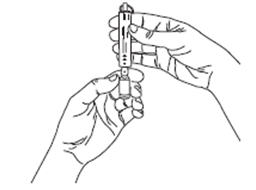
With the I-neb System, you will receive two medicine chambers (one with a red latch and one with a purple latch) and two color-matching dosing discs to use with the 10 micrograms per 1 mL of Ventavis.
I-neb System Medication Chamber
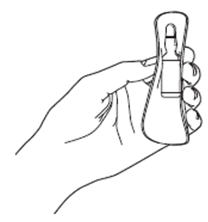
You should use the red dosing disc with the red latched medicine chamber (gives you a 2.5 microgram dose). You should use the purple dosing disc with the purple-latched medicine chamber (gives you a 5 microgram dose). Always use all of the contents of only 1 ampule when using the I-neb System.
If you are using the I-neb System and usually have long treatment times, your doctor may ask you to switch to a third medicine chamber (one with a gold latch). The medicine chamber with the gold latch and matching dosing disc are only for use with the 20 micrograms per 1 mL ampule of Ventavis. You should use the gold dosing disc with the gold latched medicine chamber (gives you a 5 microgram dose.).
Do not change the medicine chamber and dosing disc in your I-neb System without talking to your doctor.
Do not put any medicines other than Ventavis in your I-neb System.
To Use Ventavis:
Open the small glass bottle (ampule) of Ventavis by using either an ampule breaker or a rubber pad. Use either the ampule breaker or the rubber pad. You do not need to use both methods to open a Ventavis ampule.
When using an ampule breaker:
Step 1. Line up the blue dot on the Ventavis ampule with the dot on the ampule breaker, if available, and then insert the top of the ampule into the ampule breaker.

Step 2. Gently break open the neck of the ampule by pushing away from the dot on the Ventavis ampule to snap off the ampule lid.

Step 3. Carefully throw away the top of the ampule into a safe container.

When using a rubber pad:
Step 1. Hold the ampule with the blue dot facing away from your body.
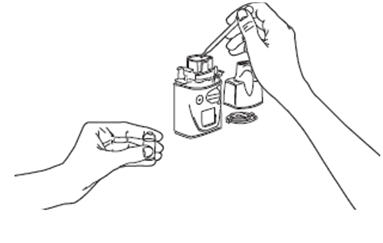
Step 2. Wrap the rubber pad around the ampule to protect yourself from getting cut.
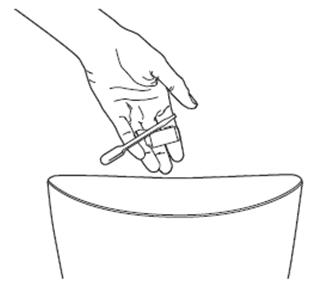
Step 3. Use your thumbs to break open the neck of the ampule by snapping the top toward you.
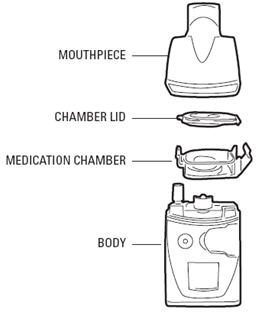
Step 4. Using the small tube (pipette ) that comes with Ventavis, draw-up the entire amount of one ampule of Ventavis and empty it into the center of the I-neb System medicine chamber. The amount of Ventavis you receive will be controlled by either the dosing disc or the medicine chamber.
I-neb System

Step 5. Throw away in a safe container the:
- top of the ampule (the ampule lid)
- open ampule
Keep both the ampule and the pipette out of the reach of children.
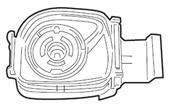
Step 6. To breathe in your dose of Ventavis, follow the instructions that come with your I-neb System. Each treatment session with Ventavis lasts about 4 to 10 minutes. Call your doctor if you usually have longer treatment times as your dose may need to be changed.
The I-neb System allows you to stop your treatment for up to ten minutes with no effect on the final dose you get. If your treatment is stopped for more than ten minutes, the I-neb System will reset itself. If that happens, throw away the solution in the chamber and wait at least two hours before taking your next dose. If you take a second dose right away you could get too much medicine.
Step 7. Throw away any Ventavis that is left in the medicine chamber after each treatment. Do not use the rest of the Ventavis because it will not give you the right dose.
Step 8. Clean your system after each treatment. Follow the instructions that come with your system.
Step 9. Make sure you have access to a back-up I-neb System to use for Ventavis treatments. This is important if your original system does not work for some reason.
Rx only
Issued 12/2019Manufactured for:
Actelion Pharmaceuticals US, Inc.
5000 Shoreline Court, Ste. 200
South San Francisco, CA 94080
©2019 Actelion Pharmaceuticals US, Inc.
ACT20191216 -
PRINCIPAL DISPLAY PANEL - 10 mcg amplule carton
NDC: 66215-302-30
Ventavis®
(iloprost)
INHALATION
SOLUTION10 mcg/1 mL
- 30 Single-Use Ampules
- Discard Any Unused Portion
- Rx Only
Contents:
30 single-use ampules. Each single-use
glass ampule contains 1 mL (10 mcg) of
the solution to be added to the nebulizer
medication chamber. Each mL of the
aqueous solution contains 0.01 mg
iloprost, 0.81 mg ethanol, 0.121 mg
tromethamine, 9.0 mg sodium chloride,
and approximately 0.51 mg hydrochloric
acid (for pH adjustment to 8.1) in
water for injection. The sterile solution
contains no preservatives.Dosage and Administration:
See enclosed full prescribing information.Storage:
Store at 20–25°C (68–77°F); excursions
permitted to 15–30°C (59–86°F) [See
USP Controlled Room Temperature]KEEP OUT OF THE REACH OF
CHILDRENACTELION

-
PRINCIPAL DISPLAY PANEL - 20 mcg ampule carton
NDC: 66215-303-30
Ventavis®
(iloprost)
INHALATION
SOLUTION20 mcg/1 mL
Each inhalation
session requires one
single-use ampule.- 30 Single-Use Ampules
- Discard Any Unused Portion
- Rx Only
- Use with I-neb AAD
System Only
Contents:
30 single-use ampules. Each single-use
glass ampule contains 1 mL (20 mcg) of
the solution to be added to the I-neb AAD
medication chamber. Each mL of the
aqueous solution contains 0.02 mg
iloprost, 1.62 mg ethanol, 0.242 mg
tromethamine, 9.0 mg sodium chloride,
and approximately 0.76 mg hydrochloric
acid (for pH adjustment to 8.4) in
water for injection. The sterile solution
contains no preservatives.Dosage and Administration:
See enclosed full prescribing information.Storage:
Store at 20–25°C (68–77°F); excursions
permitted to 15–30°C (59–86°F) [See
USP Controlled Room Temperature]KEEP OUT OF THE REACH OF
CHILDRENACTELION

-
INGREDIENTS AND APPEARANCE
VENTAVIS
iloprost solutionProduct Information Product Type HUMAN PRESCRIPTION DRUG Item Code (Source) NDC: 66215-302 Route of Administration RESPIRATORY (INHALATION) Active Ingredient/Active Moiety Ingredient Name Basis of Strength Strength iloprost (UNII: JED5K35YGL) (iloprost - UNII:JED5K35YGL) iloprost 0.01 mg in 1 mL Inactive Ingredients Ingredient Name Strength alcohol (UNII: 3K9958V90M) tromethamine (UNII: 023C2WHX2V) sodium chloride (UNII: 451W47IQ8X) hydrochloric acid (UNII: QTT17582CB) water (UNII: 059QF0KO0R) Packaging # Item Code Package Description Marketing Start Date Marketing End Date 1 NDC: 66215-302-30 30 in 1 CARTON 05/07/2005 1 NDC: 66215-302-00 1 mL in 1 AMPULE; Type 0: Not a Combination Product Marketing Information Marketing Category Application Number or Monograph Citation Marketing Start Date Marketing End Date NDA NDA021779 05/07/2005 VENTAVIS
iloprost solutionProduct Information Product Type HUMAN PRESCRIPTION DRUG Item Code (Source) NDC: 66215-303 Route of Administration RESPIRATORY (INHALATION) Active Ingredient/Active Moiety Ingredient Name Basis of Strength Strength iloprost (UNII: JED5K35YGL) (iloprost - UNII:JED5K35YGL) iloprost 0.02 mg in 1 mL Inactive Ingredients Ingredient Name Strength alcohol (UNII: 3K9958V90M) tromethamine (UNII: 023C2WHX2V) sodium chloride (UNII: 451W47IQ8X) hydrochloric acid (UNII: QTT17582CB) water (UNII: 059QF0KO0R) Packaging # Item Code Package Description Marketing Start Date Marketing End Date 1 NDC: 66215-303-30 30 in 1 CARTON 08/24/2009 1 NDC: 66215-303-00 1 mL in 1 AMPULE; Type 0: Not a Combination Product Marketing Information Marketing Category Application Number or Monograph Citation Marketing Start Date Marketing End Date NDA NDA021779 08/24/2009 Labeler - Actelion Pharmaceuticals US, Inc. (002641228)
Trademark Results [VENTAVIS]
Mark Image Registration | Serial | Company Trademark Application Date |
|---|---|
 VENTAVIS 85254212 4028843 Live/Registered |
BAYER INTELLECTUAL PROPERTY GMBH 2011-03-01 |
 VENTAVIS 76209350 2926127 Dead/Cancelled |
BAYER SCHERING PHARMA AKTIENGESELLSCHAFT 2001-02-13 |
© 2025 FDA.report
This site is not affiliated with or endorsed by the FDA.